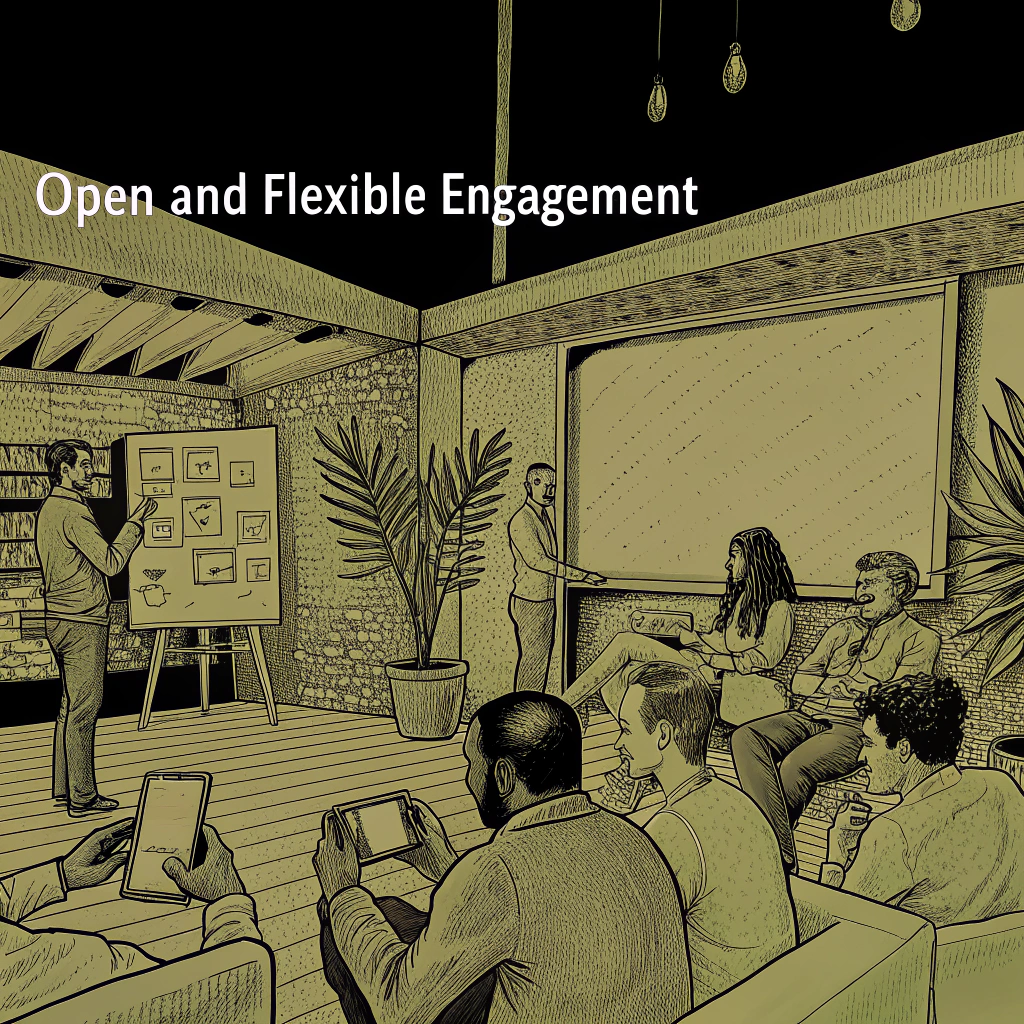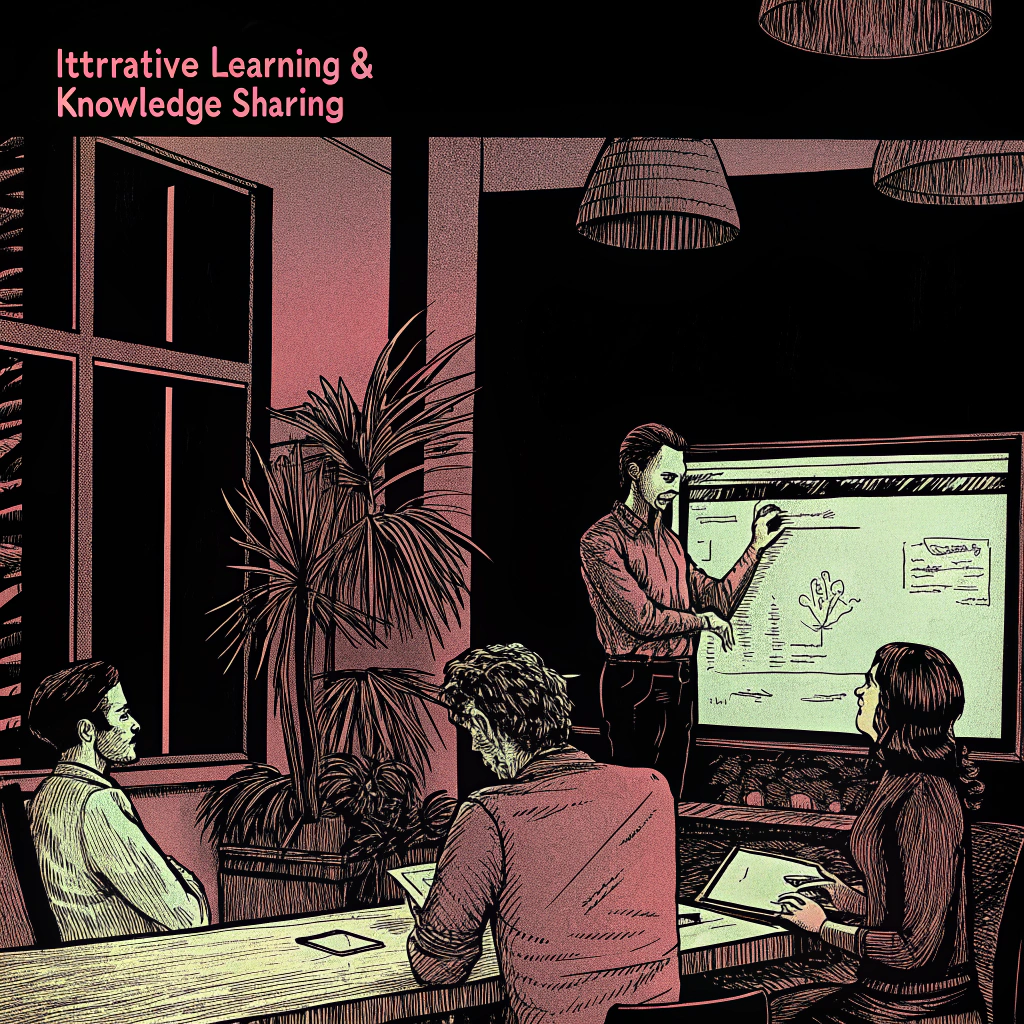Adaptive and Fluid Collaboration
While established models of collaboration, including Design Thinking and Startup Incubators, have proven effective in fostering innovation and structured project development, they may not always align with the diverse backgrounds, needs and learning trajectories of researchers involved in secondments.

The Adaptive and Fluid Collaboration approach has been developed to address this gap by offering a flexible, evolving model of collaboration that can be tailored to individual projects and institutional requirements. This method ensures that each mentoring experience remains highly personalised and adaptable, providing researchers with a self-directed, open-ended environment that encourages autonomy and interdisciplinary exchange.
This approach is based on the principle of responsive learning, allowing researchers and host organisations to co-design their collaboration and adjust it dynamically as the project unfolds.Unlike traditional mentorship structures that rely on predefined milestones and rigid frameworks, adaptive collaboration evolves organically based on:
- The specific needs of the researcher and their learning objectives.
- The capabilities and strategic focus of the hosting organisation.
- The opportunities and challenges that emerge throughout the secondment.
In a fast-paced and technology-driven world, researchers need to be agile, flexible, and innovative.
The Adaptive and Fluid Collaboration model helps participants develop this essential competency by fostering autonomy and self-direction, interdisciplinary problem-solving, sustainable networking, and opportunities for collaboration across different sectors, strengthening transferable skills. Through flexible engagement, researchers build long-term relationships that go beyond their secondment period.
In essence, this approach acknowledges that not all collaboration fits within predefined models and that real-world challenges require an adaptive mindset.
The EdTech Mentoring Approach embraces flexibility as a guiding principle, enabling a highly context-sensitive and impact-driven experience.
Steps and Goals in Adaptive Collaboration
Unlike rigid step-by-step approaches, Adaptive and Fluid Collaboration follows an iterative, evolving cycle where adjustments and reflections play a key role. While this process is dynamic, it still incorporates three essential phases that ensure a balance between flexibility and structure:

Step 1: Co-Designing the Collaboration Approach
Collaboration begins with an exploratory phase where both the researcher and the hosting organization define expectations, common interests, and practical feasibility.
This stage focuses on:
- Establishing a shared understanding of project goals, ensuring that both parties align their expectations.
- Discussing the researcher’s learning trajectory, identifying areas where the host institution can provide expertise and resources.
- Co-developing a fluid roadmap rather than rigid milestones, allowing room for experimentation and adaptation.
- Agreeing on methods of communication, feedback, and knowledge exchange, which may range from structured mentorship sessions to informal brainstorming meetings.
Outcome: A co-created collaboration framework that is flexible yet strategic, ensuring both freedom for innovation and a structured process for support.
Step 2: Continuous Learning and Iteration
Once the foundational framework is set, the collaboration evolves through dynamic iterations. The project adapts based on emerging insights, stakeholder feedback, and real-world applicability. Unlike traditional mentorship that follows predefined steps, this phase focuses on exploratory development and interactive problem-solving.
The key elements of this phase include:
- Encouraging continuous feedback loops to refine project objectives and direction.
- Using a mix of structured and unstructured collaboration models, ensuring that support is available when needed but without limiting creativity.
- Engaging in cross-sector dialogue, bringing in external perspectives through interdisciplinary discussions.
- Experimenting with multiple knowledge-sharing formats, such as workshops, peer discussions, and micro-projects, rather than relying on a single approach.
Outcome: Researchers gain iterative insights, refine their ideas, and develop a deep understanding of problem-solving in real-world contexts.


Step 3: Dynamic Output Development
Unlike traditional approaches that emphasize fixed deliverables, Adaptive Collaboration focuses on progressive knowledge generation and impact creation. This means that instead of working towards a static end goal, the project adapts to new discoveries, stakeholder needs, and market conditions.
This stage involves:
- Testing ideas through live experimentation, such as field trials, prototype feedback, or interactive pilot projects.
- Revisiting and refining the researcher’s competence development, ensuring that learning outcomes align with both academic and practical applications.
- Exploring funding, networking, and policy opportunities, ensuring that innovative ideas can be scaled beyond the secondment period.
Outcome: A meaningful research and innovation outcome that is highly applicable, transferable, and adaptable beyond the mentoring programme.
Potential and Usefulness of Adaptive Collaboration
Adaptive and Fluid Collaboration is a key approach to address the complexity and unpredictability of real-world research and professional development.In rapidly evolving fields such as EdTech, artificial intelligence, sustainability, and digital innovation, rigid frameworks often fail to capture emerging trends and spontaneous opportunities.By emphasising customized engagement and flexible structuring, this approach ensures that seconded researchers remain responsive, innovative, and aligned with real-world challenges.
A key benefit of Adaptive Collaboration is that it enables researchers to maximize their creative potential by moving beyond predefined tasks and traditional mentorship structures.By allowing room for open-ended exploration, interdisciplinary engagement, and iterative learning, researchers can refine their ideas based on direct feedback, stakeholder needs, and market dynamics.This adaptability makes the approach particularly effective for projects requiring rapid prototyping, evolving research questions, or real-world testing in diverse environments.
Furthermore, this model enhances knowledge sharing by removing barriers that often hinder research collaboration, such as intellectual property disputes or rigid publication requirements.Open, fluid engagement fosters a culture of continuous exchange, where insights from different disciplines and industries are freely shared and refined.The ability to tailor mentorship and resource access to the specific needs of the researcher and host organisation ensures that both parties derive maximum value from the experience.
Beyond the immediate benefits of project-based learning, Adaptive Collaboration also strengthens professional networks by fostering long-term relationships between researchers, industry leaders, and policy stakeholders.Unlike traditional secondments that conclude with a single project outcome, this approach encourages ongoing engagement, leading to potential future collaborations, funding opportunities, and expanded career pathways.Furthermore, it optimises resource allocation and research efficiency, allowing participants to balance expertise, funding, and institutional support more effectively.
Adaptive and Fluid Collaboration is not just an alternative to more traditional approaches, but a complementary model that acknowledges the importance of flexibility in innovation and research.By embracing context-sensitive learning, real-time adaptation, and interdisciplinary collaboration, this model prepares researchers to navigate complex challenges, drive meaningful impact, and sustain long-term professional growth.
